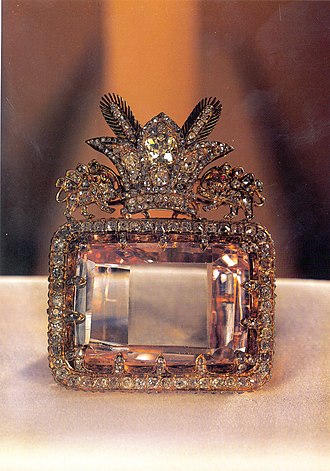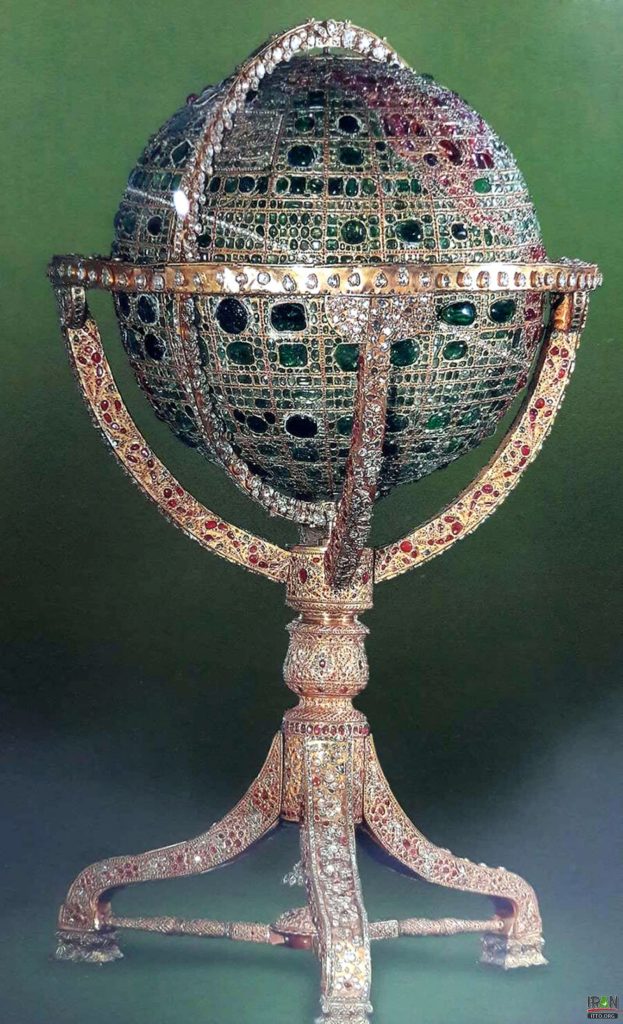Iran’s crown jewels are not merely dazzling artifacts; they are a testament to the country’s rich history, cultural evolution, and political upheavals.
Housed in the Central Bank of Iran in Tehran, this extraordinary collection is a visual narrative of Persian royalty, reflecting both the heights of imperial opulence and the shadows of political turmoil.
From the battlefield conquests of Nader Shah to the coronations of Qajar and Pahlavi monarchs, these treasures have been witnesses to centuries of triumph, transformation, and survival.
Each piece—be it the resplendent Darya-ye Noor diamond or the intricately crafted Naderi Throne—offers a portal into the cultural and historical tapestry of Iran, symbolizing both the fleeting nature of power and the enduring allure of beauty.
As the jewels stand preserved through revolutions and regime changes, they remind us not only of a bygone era but also of the timeless, elegant legacy they represent.
A Royal Legacy: Origins of the Collection


The roots of Iran’s crown jewels trace back to the Safavid Dynasty (1501–1736), with Ismail I initiating the collection. However, it was under Nader Shah’s reign (1736–1747) that the collection reached unprecedented grandeur.
After his successful campaigns, including the famed invasion of Delhi in 1739, Nader Shah returned to Persia laden with extraordinary treasures. His plunder, which included vast quantities of gold, silver, diamonds, and other jewels, is valued today at billions of dollars.
Among the most iconic pieces attributed to Nader Shah is his buckler, a shield made from rhinoceros hide and encrusted with emeralds, diamonds, and a striking red spinel. These jewels, while symbolizing military triumph, also reflected the extravagant tastes of Persian rulers.
Jewels of Power: Famous Pieces in the Collection
The collection boasts some of the world’s most famous gemstones, including the “Sea of Light” (Darya-ye Noor) diamond, a pale pink marvel weighing 182 carats, highlighting the artistry and refinement of Persian jewelers.
British diplomat Sir Harford Jones Brydges, who assessed these gems in the 18th century, marveled at their quality and uniqueness, describing the “Sea of Light” as possessing a color that enhanced its beauty rather than detracted from it.
The Naderi Throne


The Naderi Throne, a dazzling masterpiece from the Qajar era, stands as a testament to Iran’s rich cultural heritage. “Naderi” derives from the Persian word “nader,” meaning “rare” or “unique,” perfectly capturing the throne’s essence.
Crafted from wood and lavishly covered in gold, the Naderi Throne is adorned with an astonishing 26,733 jewels, including large spinels, emeralds, and rubies. Its intricate design features peacock tails, ducks, dragons, leaves, and tree branches, with a striking lion motif on the footstool.
One of the throne’s remarkable features is its portability. It can be disassembled into 12 sections, allowing it to accompany the Shah on his travels.
Darya-ye Noor Diamond


One of the largest diamonds in the world, the Darya-ye Noor (Sea of Light) is a pale pink diamond weighing approximately 182 carats. Its sheer size and unique color make it one of the most remarkable pieces in the collection.
This gem has a rich history that traces back to the Mughal Empire, and it was likely one of the eyes of the Mughal Peacock Throne before being taken by Nader Shah during his invasion of Delhi in 1739. The diamond eventually became part of the Qajar treasury and was a favorite of Naser al-Din Shah Qajar.
The Empress Farah Pahlavi Crown


The Empress Farah Pahlavi Crown is a stunning piece of Iranian history, crafted specifically for the coronation of Empress Farah Pahlavi in 1967. This event marked a significant departure from tradition, as it was the first time in centuries that an Iranian empress was crowned.
Commissioned by Mohammad Reza Pahlavi, the last Shah of Iran, the crown was designed by the renowned French jewelry house Van Cleef & Arpels.
Due to Iranian laws prohibiting the export of national treasures, the jewelers had to travel to Tehran to create this masterpiece. It is said that the process took six months and involved meticulous craftsmanship.
The crown itself is made of white gold and lined with green velvet. It is adorned with 1,469 diamonds, 36 emeralds, 105 pearls, 34 rubies, and two spinels.
The largest emerald, weighing approximately 92 carats, is prominently placed in the center of the crown’s sunburst design. The two large spinels weigh around 83 carats each, and the largest pearl measures about 22 millimeters in length.
Weighing nearly two kilograms, the crown was not only a symbol of royal splendor but also a testament to the intricate artistry of its creators.
The Kiani Crown


The Kiani Crown, a symbol of the Qajar dynasty’s grandeur, was the traditional coronation crown used from 1796 to 1925. Designed under the reign of Agha Mohammad Khan Qajar, the crown was intended to link his rule to the ancient Sasanian.
Crafted from red velvet, the Kiani Crown is adorned with thousands of precious gems. It features 1,800 small pearls, each about 7 millimeters in diameter, along with 300 emeralds and 1,800 rubies.
Among its notable stones, the largest emerald weighs an impressive 80 carats, while the largest spinel, known as the Aurangzib spinel, weighs around 120 carats. Standing 32 centimeters high and 19.5 centimeters wide, the crown’s intricate design and rich history make it a captivating piece of Iran’s royal heritage.
Globe of Jewels


The Globe of Jewels is a true marvel of artistry and opulence that sparkles with the brilliance of over 51,000 gemstones. Standing at 110 centimeters tall with a diameter of 45 centimeters, it is a display of craftsmanship, capturing the world’s geography in a dazzling display.
Emeralds shimmer as oceans, while rubies and spinels outline the continents and diamonds mark major cities.
Created during the reign of Naser al-Din Shah Qajar in the 19th century, the globe was more than just a display of wealth. It symbolized the vastness and diversity of the Persian Empire, showcasing the empire’s reach and grandeur.
The Last Shah and the Jewels’ Role in Modern Iran


Under the Pahlavi dynasty, the crown jewels assumed a new role as symbols of national pride and stability. Mohammad Reza Shah Pahlavi, Iran’s last monarch, showcased the collection at his self-crowning ceremony in 1967, often referred to as “The Coronation of the Century.”
Notable pieces included the Pahlavi Crown, adorned with emeralds and diamonds, and the Naderi Throne, an exquisite masterpiece of gemstone artistry.
In 1960, many of these treasures were moved to the Central Bank of Iran, where they served as collateral for the nation’s currency—a move that underscored their immense value and symbolic importance.
Survival Through Revolution
The 1979 Iranian Revolution marked the end of the monarchy, and with it, questions arose about the fate of the crown jewels. Unlike Russia’s crown jewels, which went missing after the 1917 revolution, Iran’s treasures remained intact.
Six months after the Shah’s departure, the collection was secured and preserved, standing as a testament to a bygone era.
Today, the jewels are displayed in Tehran, allowing the public to marvel at their beauty and historical significance while they continue to symbolize Iran’s complex relationship with its royal past.
A Heritage Preserved
Iran’s crown jewels are a dazzling reminder of the country’s storied past, its artistic achievements, and its resilience. From the battlefield to royal ceremonies and national pride, these treasures encapsulate the essence of Iran’s historical journey.
Despite their tumultuous history and shifting political landscapes, the jewels remain a significant part of Iran’s cultural heritage, offering a glimpse into the grandeur of its royal traditions and the enduring legacy of Persian craftsmanship.
WE ALSO SAID: Don’t Miss… From Sand to Sparkle: Exploring the Precious Stones of MENA



